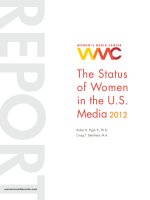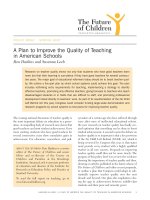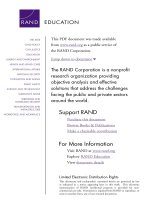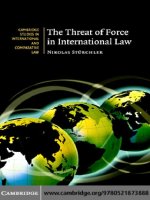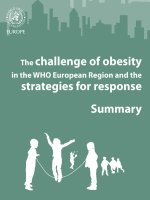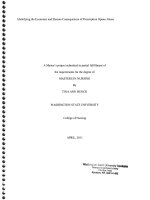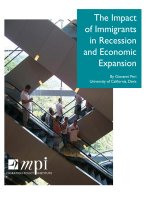THE FATE OF BIODIVERSITY IN MODIFIED TROPICAL FORESTS
Bạn đang xem bản rút gọn của tài liệu. Xem và tải ngay bản đầy đủ của tài liệu tại đây (4.59 MB, 126 trang )
THE FATE OF BIODIVERSITY IN
MODIFIED TROPICAL FORESTS
LUKE GIBSON
(B.A. Princeton University, M.S. UC San Diego)
A THESIS SUBMITTED FOR THE
DEGREE OF DOCTOR OF PHILOSOPHY
DEPARTMENT OF BIOLOGICAL SCIENCES
NATIONAL UNIVERSITY OF SINGAPORE
2014
DECLARATION
I hereby declare that this thesis is my original work and it has been written by
me in its entirety. I have duly acknowledged all the sources of information
which have been used in the thesis.
This thesis has also not been submitted for any degree in any university
previously.
_________________________
Luke Gibson
7 July 2014
ii
ACKNOWLEDGMENTS
Ideas for my PhD began forming almost a decade ago, in Christmas 2005
during a visit to Chiew Larn Reservoir, Thailand. I had been studying Phayre’s
leaf monkeys in another part of the country, and met my parents in the south
over the holidays. The reservoir was spectacular – surrounded by vertical
mountains of gray karst piercing the sky and forest of sundry shades of green
extending to the horizon – where we listened to calls of great hornbills, white-
handed gibbons, and leaf monkeys, of another species. That calling to nature –
and particularly to the rainforest – I owe to my parents. Thank you, Mom and
Dad, for giving me an admiration for the natural world beyond our backyard.
I am grateful to the many people who were essential towards the completion
of this complicated path to PhD. David Woodruff supported me at UC San
Diego and brainstormed with me about plans for resurveys in Chiew Larn. I
am thankful to friends in San Diego who encouraged me to pursue other
options when funding sources evaporated along with the US financial system.
There are over 7 billion people on the planet, but it really is a small world. In
San Diego I was lucky to meet Tien Ming Lee, who introduced me to the
legendary Navjot Sodhi in Ming’s city state home of Singapore. I moved to
the Little Red Dot in 2010 to continue my PhD at the National University of
Singapore with Navjot, who motivated me and stimulated my research in a
way that no one had before.
Though I had only known Navjot for little over a year, his loss was
devastating. I am grateful to all lab members, alumni, and collaborators who
came together and offered support after his death. With the aim to continue
producing the best conservation science in the void that Navjot left, I must
give special thanks to the Singapore Mafia of Lian Pin Koh, Tien Ming Lee,
and Xingli Giam, collaborators from Australia, whether native (Barry Brook)
or invasive (Bill Laurance, Corey Bradshaw), and elsewhere around the world,
particularly to Fangliang He, Carlos Peres, and Peter Raven.
iii
Once field work started in Chiew Larn, I am grateful to Tony Lynam for the
hammock that supported me nearly every night during field work, and for
invaluable advice that kept my project afloat in challenging times. I also thank
Sara Bumrungsri, the National Research Council of Thailand, the Department
of National Parks, Wildlife, and Plant Conservation, and the staff of Khlong
Saeng Wildlife Sanctuary and Khao Sok National Park for permission to
conduct research. I am tremendously grateful to all field assistants, particularly
to Krum Nungnuam and Phairote Rhittikhun, respectively the most skilled
forest man and boat man I have ever known. Thank you both – and your
families, particularly Junpaa Rhittikhun – for welcoming me into your home.
Research funding was provided by the National University of Singapore and
the Ah Meng Memorial Conservation Fund, and my graduate fellowship was
sponsored by the Singapore International Graduate Award and the President’s
Graduate Fellowship. I thank staff of the Department of Biological Sciences,
including Tommy Tan, Priscilla Li, Laurence Gwee, and particularly Reena
Devi and Department Head Paul Matsudaira whose support never wavered.
I thank committee members Roman Carrasco, Ryan Chisholm, and Richard
Corlett for their time and constructive feedback on my dissertation. Ryan
provided inspiration as I prepare to transition from life as a graduate student to
life as a faculty member. For making that transition, I thank my fourth and
final PhD advisor, David Bickford, who helped me think about the future. I am
also grateful to Theo Evans for invaluable advice as I expand my research into
other directions.
I am forever indebted to my lab mate Brett Scheffers, who learned to climb
trees for research based in Singapore and the Philippines. It probably saved
my life in another part of the tropics.
Last but not least, my final recognition goes to Em. Thank you for always
standing by me and giving me your support, through good times and bad.
v
TABLE OF CONTENTS
Summary vii
List of Tables ix
List of Figures ix
Introduction: The Extent and Status of Tropical Forests 1
Chapter 1: Primary Forests are Irreplaceable for Sustaining 6
Tropical Biodiversity
Introduction 6
Methods 8
Results and Discussion 15
Chapter 2: Near-Complete Extinction of Native Small Mammal 23
Fauna 25 Years After Forest Fragmentation
Introduction 23
Methods 25
Results and Discussion 29
Chapter 3: Avoiding Deforestation Trumps Forest Restoration 34
for Conserving Biodiversity
Introduction 34
Methods 36
Results and Discussion 44
Conclusion: Strategies for Sustaining Tropical Biodiversity 48
References 52
Appendix I: Gibson et al. Nature 2011 67
Appendix II: Gibson et al. Science 2013 92
vii
SUMMARY
Tropical forests hold half of all species on the planet, but are being rapidly lost
or disrupted by agricultural expansion, logging, and other human enterprises.
In my thesis, I examined the fate of biodiversity in modified tropical forests in
three original ways. First, I compiled data from published studies around the
global tropics and used a meta-analysis to assess the relative biodiversity value
of regenerating, logged, and other disturbed forests. Second, I surveyed small
mammal communities in forest fragments over multiple time periods to
measure the rate of species loss – and thereby gauge the time available to avert
extinctions in fragmented forest landscapes by implementing conservation
actions. Third, I modeled projected biodiversity impacts of various scenarios
combining different levels of deforestation and forest restoration to assess the
potential of regenerating forests to offset biodiversity loss due to deforestation.
My results highlight the vulnerability of tropical forests to substantial and
rapid biodiversity loss and also identify the best strategies to stem this loss –
by preserving remaining expanses of undisturbed forest, protecting modified
forests with highest biodiversity value (e.g., logged forests), and rapidly
restoring forest connectivity in fragmented landscapes.
ix
LIST OF TABLES
2.1: Number of small mammal species found on islands 29
3.1: WRI forest classes 37
3.2: Projected biodiversity losses under different scenarios 45
LIST OF FIGURES
1.1: Map of study sites by country and by study location 16
1.2: Box plots of bootstrapped effect size 17
1.3: Box plots of bootstrapped effect size 18
2.1: Islands sampled in Chiew Larn Reservoir, Thailand 25
2.2: Small mammal species richness per transect 29
2.3: Loss of species from forest fragments of various sizes 31
3.1: Deforestation and forest restoration under mitigating scenarios 38
3.2: Improvement in biodiversity among mitigating scenarios 46
3.3: Required improvement in matrix quality to offset biodiversity loss 46
1
INTRODUCTION: The Extent and Status of Tropical Forests
As human populations continue to expand, projected to exceed 9 billion by the
middle of this century (United Nations 2013), ecosystems of the world upon
which human society depends face mounting threats. Already, 75% of the
world’s land surface has been utilized by human populations, leaving few
areas free of human disturbance (Ellis & Ramankutty 2008, Ellis et al. 2010).
Overall, growing human populations and land-use demands have made largely
negative impacts on biodiversity (Pereira et al. 2012). Habitat loss – and other
forms of land-use change – is the leading cause of biodiversity loss (Pimm et
al. 1995, Brooks et al. 1999, Pimm & Raven 2000), which has escalated
extinction to rates estimated to be 1000 times higher than normal (Pimm et al.
2014). Sustaining biodiversity with future land-use demands presents one of
the major challenges of the twenty first century (Foley et al. 2011, Lambin &
Meyfroidt 2011, Ellis 2013).
Tropical forests, which sustain the majority of all species (Dirzo &
Raven 2003), have suffered severely. Half of the humid tropical forest biome
has lost more than 50% of forest cover due to logging and forest clearance
(Asner et al. 2009), and rates of deforestation are rising (Hansen et al. 2013).
Even the quantity of biodiversity in this habitat remains uncertain; most
species within tropical forests remain undescribed (Costello et al. 2013) and
are concentrated in those regions with minimal human disturbance (Giam et
al. 2011). Fires and logging operations have penetrated even the most remote
tropical forests (Nepstad et al. 1999, Asner et al. 2009), threatening the
unknown multitude of species that occupy the biologically richest habitat.
2
Despite these threats, many parts of the tropics are experiencing a
forest transition, a shift from shrinking to expanding forest area (Mather
1992), as forests regenerate in abandoned agricultural and other previously
deforested lands. This transition is not just a shift in area, but is also usually a
transformation in forest status as undisturbed “primary” forests are replaced by
regenerating “secondary” forests and other reforested lands of unknown
biodiversity value. This forest transformation has been widespread: of 106
tropical nations, 87 (82%) reported greater area of secondary forest than
primary forest, and worldwide primary forests represent less than 30% of
tropical forest cover (FAO 2010). Furthermore, most nations that have
experienced forest transitions have simply exported land-use demand – and
deforestation – to other countries (Meyfroidt et al. 2010). For example, though
Vietnam experienced net gain in forest cover since the 1990s, this was
accompanied by an increase in timber imports from neighboring countries
(Meyfroidt & Lambin 2009). As such, although forest transition may relieve
environmental pressures within an individual country, globally it could have
detrimental impacts on forests and their biodiversity, especially if land-use
demands are displaced to those countries that still sustain high cover of
undisturbed forest (Meyfroidt et al. 2010).
Some have argued that this forest transition will minimize extinctions
due to deforestation, as species colonize and persist in regenerating forests
(Wright & Muller-Landau 2006a). This perspective triggered a debate over the
future of biodiversity in tropical forests (Brook et al. 2006, Wright & Muller-
Landau 2006b, Gardner et al. 2007, Laurance 2007, Bradshaw et al. 2009),
which focused largely on two assumptions originally made by Wright &
3
Muller-Landau (2006a). The first argued that recent trends of decreasing rural
populations will allow forests to regenerate on lands previously utilized for
agricultural production. However, drivers of deforestation have changed over
the past several decades, from smallholders clearing small patches of forest
through 1985 to large-scale agribusiness industries clearing large expanses of
forest since then (Rudel et al. 2009), and as such population trends in rural
landscapes may not drive deforestation patterns. Indeed, recent deforestation
patterns were found to be associated not with rural population change, but
with urban population growth and agricultural exports (DeFries et al. 2010).
Although regenerating forests have expanded throughout the tropics (Chazdon
2014), land-use demands have resulted in a net loss of forest cover (Hansen et
al. 2013), disputing the first assumption of Wright & Muller-Landau (2006a).
Forest cover trends may change in the decades ahead, but even so the
impact on biodiversity remains uncertain. The second assumption made by
Wright & Muller-Landau (2006a) was that the biodiversity value of
regenerating forests was equal to that of primary forests. Although the
biodiversity value of secondary forests is uncertain (Gardner et al. 2007,
Chazdon et al. 2009a), it is certainly lower than that of primary forests. But
just by how much? Some studies have quantified the value of secondary
forests (Dunn 2004, Bowen et al. 2007, Chazdon et al. 2009b, Dent & Wright
2009), but many of these studies are based in young secondary forests which
may not represent the potential of older secondary forests (Chazdon 2014).
Further research is needed to measure the role of regenerating forests in
sustaining biodiversity in tropical forest landscapes, which are changing
rapidly due to expanding human enterprises.
4
The fate of biodiversity in tropical landscapes largely depends on the
future of the remaining undisturbed forest patches and the species that inhabit
them and the potential of regenerating forests to sustain those same species.
Research and conservation efforts are greatly needed in both the last
remaining wild lands and in recovering habitats, to establish a baseline and to
assess the prospect of regenerating habitats to match that baseline (Ellis. et al.
2010). That was the purpose of my dissertation. In whole, my thesis examines
the current biodiversity status of undisturbed and a wide suite of modified
tropical forests, the fate of biodiversity occupying remnant undisturbed forest
patches, and the prospect of regenerating forests to stem the loss of
biodiversity associated with deforestation. These chapters will contribute to
our understanding of biodiversity in the richest habitat on the planet which is
being altered in a way that could cause it to become something less.
My thesis is divided into three chapters. In the first chapter, I selected
the best available studies measuring the biodiversity value of undisturbed
primary forests and adjacent modified forests. This literature review covered
the widest range of modified forest landscapes to date, including agricultural
croplands, pastures, and plantations, secondary forests, and selectively logged
forests. I compared biodiversity values – relative to primary forests – across
the different disturbed forest classes, across four taxonomic groups, and across
four regions to identify patterns of biodiversity depletion. This chapter
provides the first global assessment of the biodiversity value of different
modified forest habitats, including regenerating forests, and could thereby help
identify the best ways to manage agricultural production and conservation
efforts in tropical landscapes.
5
As the wave of deforestation spreads across the tropics, much of the
remaining forest persists in small isolated patches. Past studies have shown
that the fragmentation of this habitat has profound effects on its resident
biodiversity (Laurance et al. 2011), with fewer species persisting in smaller
forest fragments. However, this loss of species occurs over some relaxation
period, giving conservationists some time to avert extinctions by restoring
forest connectivity. The second chapter of my thesis addressed this question. I
resurveyed small mammals on forest islands in a hydropower reservoir in
Thailand to measure rates of extinction in forest fragments. This research was
based in Southeast Asia, which faces the highest deforestation rates of tropical
regions (Achard et al. 2002, Mayaux et al. 2005, Hansen et al. 2013) and thus
has the greatest urgency to assess rates of biodiversity depletion – and the
window of time available for intervention – in fragmented landscapes.
The limited extent of undisturbed forest tracts and their vulnerability to
biodiversity loss caused by fragmentation suggests that the future of tropical
nature may depend on regenerating forests. I examined their prospect to
sustain biodiversity in the third chapter of my thesis. Using recent
deforestation rates, forest restoration targets, and species-area models, I
compared biodiversity impacts of various scenarios that combine different
levels of deforestation and forest restoration.
These chapters add to our understanding of the fate of biodiversity in
tropical landscapes – whether in remnant undisturbed forest expanses, in
modified forests, or in regenerating forests. The relative value of different
forest types can help determine the best combination to sustain biodiversity in
tropical landscapes, which are changing more rapidly than ever before.
6
CHAPTER 1: Primary Forests are Irreplaceable for Sustaining Tropical
Biodiversity
Human-driven land-use changes increasingly threaten biodiversity,
particularly in tropical forests where both species diversity and human
pressures on natural environments are high. The rapid conversion of tropical
forests for agriculture, timber production and other uses has generated vast,
human-dominated landscapes with potentially dire consequences for tropical
biodiversity. Today, few truly undisturbed tropical forests exist, whereas those
degraded by repeated logging and fires, as well as secondary and plantation
forests, are rapidly expanding. Here I provide a global assessment of the
impact of disturbance and land conversion on biodiversity in tropical forests
using a meta-analysis of 138 studies. I analyzed 2,220 pairwise comparisons
of biodiversity values in primary forests (with little or no human disturbance)
and disturbed forests. I found that biodiversity values were substantially lower
in degraded forests, but that this varied considerably by geographic region,
taxonomic group, ecological metric and disturbance type. Even after partly
accounting for confounding colonization and succession effects due to the
composition of surrounding habitats, isolation and time since disturbance, I
find that most forms of forest degradation have an overwhelmingly detrimental
effect on tropical biodiversity. My results clearly indicate that when it comes
to maintaining tropical biodiversity, there is no substitute for primary forests.
Introduction
As the extent of primary forests is shrinking throughout the tropics, a growing
body of work has quantified the biodiversity values of degraded tropical
forests. The ecological responses following forest conversion vary markedly
across taxonomic groups, human impact types, ecological metrics and
geographic regions (Barlow et al. 2007, Gardner et al. 2009, 2010, Stork et al.
2009). Most studies, however, provide limited insight into the varied
7
responses of tropical forest biota to human impacts because they are
understandably restricted to particular disturbance types (Dent & Wright 2009,
Edwards et al. 2011), taxa (Hughes et al. 2002, Horner-Devine et al. 2003)
and geographic regions (Sodhi et al. 2009). Therefore, their often contrasting
conclusions might have clouded ongoing debates over the conservation value
of modified forest ecosystems (Laurance 2007). A comprehensive meta-
analysis of the conservation value of human-modified tropical forests is
therefore sorely lacking. Notably, such an assessment could provide a critical
baseline for monitoring progress towards global conservation targets (Walpole
et al. 2009), evaluate the biodiversity benefits of international carbon-trading
initiatives to reduce emissions from deforestation and forest degradation (for
example, the United Nations REDD+ program; Harvey et al. 2010, Strassburg
et al. 2010), and guide policy development through the integration of
biodiversity data into the modeling of land-use change scenarios (Sala et al.
2000, Koh & Ghazoul 2010b, Pereira et al. 2010).
Here I conduct a global meta-analysis to measure the varied effects of
land-use change and forest degradation on biodiversity in tropical forests.
From an exhaustive literature search, I identified 138 studies that reported
measures of biodiversity from multiple sites in both primary and disturbed
tropical forests. I necessarily assumed that all ‘primary forests’ referred to in
my source literature are largely old-growth forests that have experienced little
to no recent human disturbance, although I recognize that in reality few
primary forests are likely to be genuinely pristine. Primary forests are starkly
differentiated from disturbed sites, which encompass the full spectrum of
degraded and converted forest types, including selectively logged forests,
8
secondary forests and forests converted into various forms of agriculture. In
total, these studies spanned 28 countries and 92 study landscapes (Figure 1.1).
Methods
Data
I searched for all relevant research articles published between 1975 and
October 2010 using Web of Science and BIOSIS with the search query (TS =
[(bird* OR mammal* OR reptile* OR amphibia* OR arthropod* OR plants*
OR lepidoptera* OR hymenoptera* OR arachnid* OR coleoptera* OR
diptera* OR homoptera* OR isoptera*) AND (clear-cutting* OR log* OR
deforestation* OR fire* OR agriculture conversion* OR disturbance* OR
degradation* OR secondary forest* OR plantation* OR fragment*)]). From
this list, I reviewed articles and retained those studies that (i) included
measures of biodiversity at multiple sites in both primary and disturbed
tropical forests, (ii) indicated that the primary forests had little or no human
disturbance and (iii) reported variance measures for biodiversity responses. I
defined primary forests as primary or old-growth forests that have never been
clear-felled and have been impacted by little or no known recent human
disturbance.
For each study, I recorded the biodiversity measures in both primary
and disturbed forest sites. For those studies that reported results in figures
only, I extracted results using DATATHIEF (). The
full data set is available online at
n7369/full/nature10425.html. For each comparison, I recorded the region
(Africa, Asia, Central America (including Mexico), South America) and broad
9
taxonomic group (arthropods, birds, mammals, plants). Although arthropods
span diverse groups with potentially differing responses to human impacts
(Barlow et al. 2007), my sample included predominantly insects (Coleoptera,
29.2%; Hymenoptera, 22.9%; Lepidoptera, 22.6%) and I therefore treated it as
a single group but reported differences between the three major insect orders
represented. Mammals also comprised different groups, and I differentiated
between bats (51.0%), large mammals (2.6%), primates (3.7%), small
mammals (28.2%) and a miscellaneous group (14.4%).
I classified the biodiversity measure into five response metrics:
abundance (for example density, capture frequency, occupancy estimates and
biomass); community structure and function (for example abundance of
different guilds (generalists, herb specialists and so on), proportion of trait
states and individual weight); demographics (for example density of different
age classes (adults/juveniles/saplings/seedlings), fruit/flower production and
genetic measures); forest structure (for example canopy height/cover/
openness, basal area, litter depth, diameter at breast height and other physical
structural measurements, and density of trees of a given diameter at breast
height); and richness (for example observed/estimated/rarefied richness,
species density and genera/family richness). I omitted diversity indices (n =
151; for example Fisher’s alpha, Shannon–Wiener, Simpson’s and Margalef’s)
because they were usually secondary (derived) measures of abundance and/or
richness and are not straightforward to interpret.
I recorded the disturbance type as specified by the authors of the
source literature, which formed twelve distinct groups: abandoned agriculture,
active agriculture, agroforestry, burned forests, clear-cut forests, disturbed/
10
hunted forests, other extracted forests, pastures, plantations, secondary forests,
selectively logged forests and shaded plantations. To avoid an inadequate
treatment of forest fragmentation, which is an important topic, I necessarily
excluded data on forest fragments. However, I recognize that remnant forest
fragments, particularly large ones, in heavily human-modified ecosystems
might be critical for biodiversity persistence.
In addition, and where available, I collected data on patch size,
surrounding habitat type, isolation distance and time since disturbance (Prugh
et al. 2008, Sodhi et al. 2009). I categorized the predominant surrounding
habitat of disturbed forests into five broad groups: natural vegetation (that is,
primary and selectively logged forests), agriculture, disturbed forests, pastures
and tree plantations. Using maps and/or geo-referenced locations from the
source literature, I calculated isolation distance as the mean distance between
disturbed sites and the nearest primary forest site to account for colonization
effects for a smaller set of the data. I measured time since disturbance as the
amount of time that had elapsed between the most recent form of disturbance
and the time of study, as indicated by the authors of the source literature, to
account for post-disturbance and time-lag effects. I excluded patch size or area
information from the analysis largely as a result of ambiguity and extremely
low sample size (22.6% of the comparisons provided this information for
disturbed sites). The potential confounding effects of area have already been
acknowledged in detail elsewhere (Sodhi et al. 2009).
Meta-analysis
For each comparison, I calculated Hedges’ g, the difference between primary
11
and disturbed group means standardized using the pooled standard deviation
of the two groups (Borenstein et al. 2009), defined as:
pooled
distur be dprimary
SD
xx
g
−
=
where SD
pooled
equals
2
)1()1(
22
−+
−+−
distubedpr imary
disturbe ddisturbe dprimaryprimary
nn
SDnSDn
Because Hedges’ g is a biased estimator of population effect size, I used the
conversion factor J to compute a bias-corrected metric, g* (Borenstein et al.
2009), defined as g* = J × g, where
1)2(4
3
1
−−+
−=
disturbedprimary
nn
J
I then calculated the average effect size using the random-effects model,
where effect sizes of individual comparisons are weighted by the inverse of
within-study variance plus between-study variance (Borenstein et al. 2009).
For individual comparisons, I defined the effect size as positive for
comparisons where the biodiversity value was higher in primary forest (such
that a positive effect size indicates a more detrimental impact by the
disturbance type). For a small subset of comparisons where the expected value
would be lower in primary forest (n = 180, 8.1% of all pairwise comparisons;
for example measures of saplings/seedlings/juveniles, early/mid-successional
12
species, non-forest/open-forest species, common/generalist/visitor species,
trees of diameter at breast height <10"cm, dead/new trees and mortality/
recruitment rates), I defined the effect size as negative for comparisons where
the biodiversity value was higher in primary forest. As results might be
affected by the selection of comparisons with an opposite expectation of the
direction of the effect, I repeated the procedure after omitting those
comparisons. This led to an effect size of 0.45 (0.38–0.52), within the error of
the effect size for the full data set, suggesting that my expectation did not
affect the results (see Supplementary Table 1 in Appendix I).
I calculated the effect size for the entire data set, for each subgroup of
the four variables (region, taxon, response metric and disturbance type) and
for each of the six two-level combinations of the four variables (for example
disturbance type × region) (Figure 1.3, see also Supplementary Figure 1 and
Supplementary Tables 2–4 in Appendix I). For all combinations, I repeated
this procedure after resampling the random-model effect size calculations
using 10,000 bootstrap samples (with replacement), from which I generated
95% confidence intervals (Efron & Tibshirani 1991). To address potential
spatial and temporal autocorrelation from studies that included several
comparisons (for example multiple measurements of the same taxa,
measurements of multiple taxa and measurements of multiple disturbance
types), I repeated this procedure after resampling one comparison per study,
again using 10,000 bootstrap samples (see Supplementary Table 1 in
Appendix I). However, some autocorrelation (largely only spatial) remains
because several studies were situated in the same site (Figure 1.1), although
probably not as pronounced as above. To account for the potential influence of
13
the surrounding habitat, I repeated the above calculations for a subset of the
data set with natural surrounding habitat (70.1% of data; see Supplementary
Table 1 in Appendix I).
I tested for publication bias using two methods to assess whether
calculated effect sizes were affected by the possible absence of studies not
published owing to a failure to detect differences (Borenstein et al. 2009).
First, I visually examined a funnel plot of effect size plotted against standard
error to assess the symmetry of study precision around effect size (see
Supplementary Figure 3 in Appendix I). The relatively symmetrical funnel
plot suggests there is no relationship between effect size and study size, and
that those studies with small (or negative) effect sizes do not have a lower
probability of being published. Second, I sorted the data set by precision, from
comparisons with small standard errors to those with large standard errors, and
examined the change in cumulative effect size with the addition of the most
imprecise studies (see Supplementary Figure 4 in Appendix I). Although the
addition of the most imprecise third of comparisons (those with the largest
standard errors) does cause the cumulative effect size to increase, the effect
size remains positive and the 95% confidence interval does not overlap with
zero at any point after the first 163 comparisons. I conclude that the impact of
publication bias in this study is slight (Borenstein et al. 2009).
Generalized linear models
Following Sodhi et al. (2009), I performed an information-theoretic evaluation
of a candidate set of generalized linear models (GLMs) to examine the
influence of a set of hypothesized factors on the ecological responses

